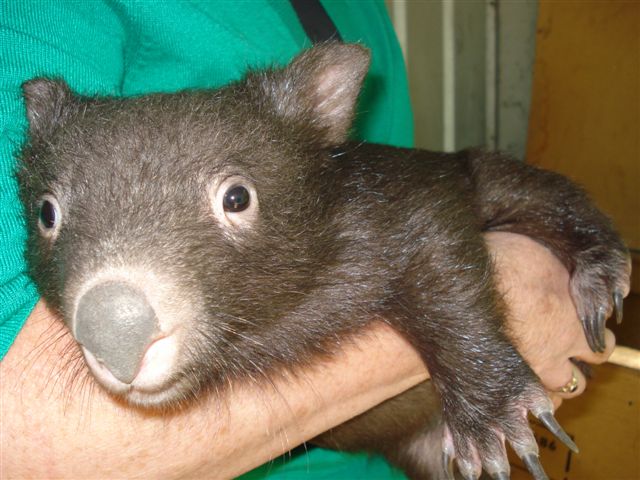WHEN A NEW ORPHAN ARRIVES IT MAY PRESENT WITH ONE OR MORE OF THE FOLLOWING CONDITIONS
• Dehydration
• Stress
• Open wounds, Skin Infections, Fractures, Head Trauma
The longer an orphaned joey has been on it’s own, the more likelihood there could be problems.
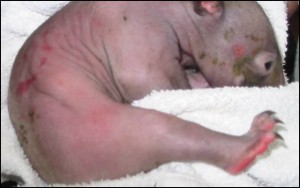
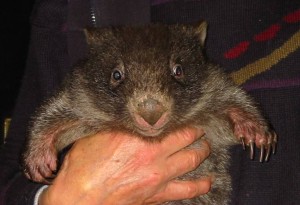
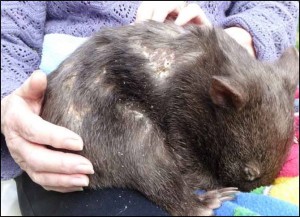
THINGS TO HAVE ON HAND
Re-hydration – suggested options
• Lectade,
• Vytrate,
• Glucose and water
Alternately, mix 1 cup warm boiled water, 1 teaspoon sugar and a pinch of salt. (A good standby in an emergency )
Stress – Thrush (can be caused by stress)
- Mycostatin Oral Drops (used to treat oral candidal infections)
or
Nilstat Oral Drops – (used to treat oral candidal infections)
These are available at the chemist and good to keep on hand (need to be kept refrigerated).
Wounds
- Step 1. Clean with: Saline, Betadine (can be diluted), Hexawash or other antiseptic solutions,(used to clean wounds)
- Step 2. Silvazine (applied to assist healing) There are other products available that may be more suitable, check with your vet for advice.
Dry Irritated Skin
- Alpha Kerri oil, glycerine & water, sorbolene (used to treat dry skin) .
Pain
- Painstop Daytime Oral (1ml per 2.5kg every 8 hours) or Panadol Infant Drops Oral (1ml per 2.5kg every 8hrs)
THRUSH (a fungal/yeast overgrowth)
Thrush is a common problem in orphaned joeys following antibiotic treatment which kills intestinal bacteria.
Also joeys that are newly orphaned sometimes present with Thrush.
This can be a result of the trauma of being orphaned or not being handled correctly, as well as any other stressful situation. A snug secure pouch away from loud noises will help reduce stress.
Symptoms
First sign is lethargy and a reluctance to drink as the joeys mouth will be quite sore. Thrush is usually noticeable in the first week or so of coming into care. The joey may present with white patches in the mouth, (this is often hard to see). In advanced stages this can also be seen around the cloaca. Faeces may become green, loose and smelly.
Treatment
As above the best treatment is Mycostatin Oral Drops or Nilstat Oral Drops, given 3 times a day for 7 days. (0.2ml x 3 times a day would be appropriate for a 1 – 2 kg joey). Improvement should be seen after 24 hours (always finish the entire course to avoid a relapse).
NOTE – New orphaned joeys 2 kgs and over are often difficult to handle and refuse to take a bottle. Don’t confuse this with Thrush. Wombats of this size know they are wombats and don’t want to be handled and can be very difficult to feed. This can go on for quite a few days. The best way to overcome this problem is to offer a little often and they will gradually get used to the new routine.
DIARRHOEA
However, if your wombat refuses his bottle, appears lethargic (tired) and feels cold (hypothermic) and is passing offensive liquid – you probably have a major problem needing assistance. Keep the joey quiet and warm and seek veterinary advice.
Is it a management problem? (stress, hygiene) or an infection problem (bacterial/viral)? Diarrhoea is one of the most common problems with hand raised wombats. There are many reasons for this, often involving a combination of causes.
Is it stress? – being newly orphaned, handled by humans and a change in environment. It can usually be corrected if you follow the guidelines already set out in these notes. However, diarrhoea may also indicate serious fungal or bacterial infections (really bad offensive smell usually indicates infection).
Contact your Veterinary Surgeon for advice (make sure you take a fresh, sterile faecal sample with you).
A joey wombat only being fed milk formula usually passes mustard colored paste, this gradually forms into small soft pellets. Once they are eating grass the droppings will be dark colored, formed firm pellets.
Treatment
If diarrhoea persists longer than 12 hours stop all milk formula for the next 24 hours. This will rest the stomach and give it a chance to recover. It is important to make sure the joey has plenty of rehydrating fluids to replace lost fluids caused by the diarrhoea. It doesn’t take long for a baby to get dehydrated.
If the diarrhoea stops or slows down considerably after this time then gradually start to reintroduce the milk formula. Start by offering the formula at half strength for the first feed and see if the wombat tolerates this, then slowly reintroduce the formula to full strength.
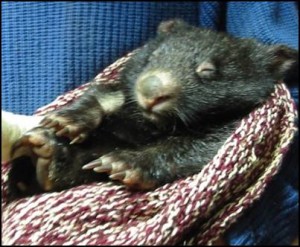
A snug pouch will help to reduce stress
CONSTIPATION
If your joey seems constipated offer a drink of water between feeds. Encourage the joey to exercise (walk around slowly or maybe a short game while you sit on the floor and supervise. A gentle massage (circular motion) on the stomach sometimes gets things moving.
If the joey starts to stretch and walk backwards or develops uncontrollable twisting and rolling this is an indication of severe pain. These symptoms can occur with a change in diet or may indicate something more serious. Seek advice from an experienced wombat carer or vet.
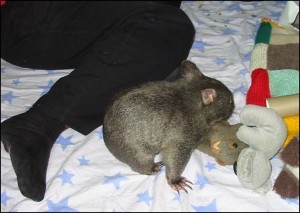
A little exercise may get things moving
MORE THAN ONE PROBLEM
This little wombat was found living under a derelict house. It was malnourished, dehydrated had broken ribs and ringworm.
Although there isn’t any treatment for broken ribs it helps if you are aware of the injury and then extra care can be taken when handling the wombat. It should be kept on its own (to avoid further injury and stress) until it is starting to move around and wants to play. This could take a few weeks.
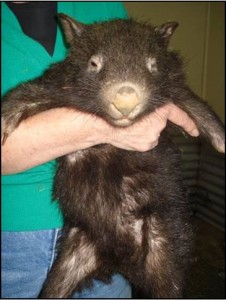
RINGWORM (external fungal infection)
The orphan will present with red, circular, itchy patches on skin, and hair loss is usually visible. Veterinary treatment is required. If infected skin is tested under an ultra violet light it may glow green indicating ringworm is present.
Lamisil cream (can be used to treat fungal infections) check with your vet for other options.
In severe cases bathing the wombat in Malaseb medicated foam every second day will assist in recovery.
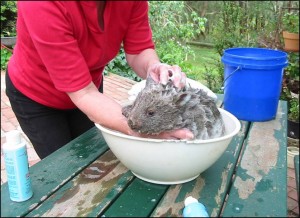
Bathing in Malaseb Medicated Foam
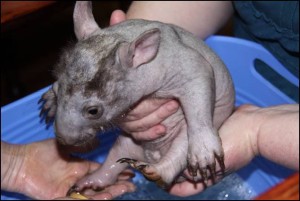
BREAKS, FRACTURES & DISLOCATIONS – Read more…
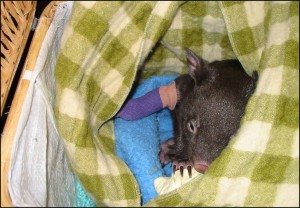 |
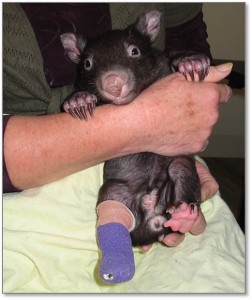 |
These need to be dealt with as soon as possible (in the first 24 – 48hours). Remember the trauma of being orphaned will be an ordeal and cause stress and if an injury has also occurred this will cause more stress.
- Give the joey time to adjust to its new surroundings. (quiet environment, snug secure pouch)
- Offer fluids (dehydration)
Examine the joey sitting on your knee in the security of it’s new pouch.
- Check eyes. Is there any rapid eye movement? (this may indicate head trauma).
- Compare limbs. Do they look the same? Is there any swelling, heat?
- Is there any offensive smell? look for puncture wounds (often hard to see through the fur) open wounds (often around the rump, back of neck and ears). These will need to be cleaned thoroughly as above, and antibiotics will be needed to clear up infection. Depending on the severity of the wounds vet assistance may be needed.
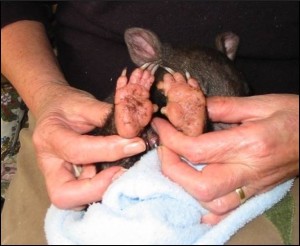
This little joey was found after wandering on his own for a period of time. It was winter and the cold wet grass had caused his feet to swell and blister and his claws had become infected. He needed a course of antibiotics to clear the infection and cream to sooth his feet. He made a full recovery.

